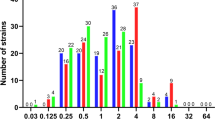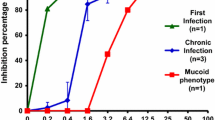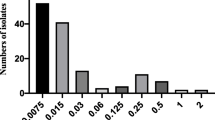Abstract
Effects and mechanism of carbonyl cyanide chlorophenylhydrazone (CCCP) on antimicrobial activity of florfenicol (FF) and thiamphenicol (TAP) were investigated against amphenicol-resistant Actinobacillus pleuropneumoniae and Pasteurella multocida isolated from diseased swine. Broth microdilution and time-kill assays indicated that CCCP dose-dependently and substantially (4-32 fold MIC reduction) improved amphenicol antimicrobial activity. When combined with CCCP at the lowest literature reported dose (2-5 μg/mL), 85% FF resistant A. pleuropneumoniae and 92% resistant P. multocida showed significantly reduced FF MICs (≥ 4-fold). In contrast, none or few of the susceptible A. pleuropneumoniae and P. multocida had FF MICs reduction ≥ 4-fold. 90% FF resistant A. pleuropneumoniae and 96% resistant P. multocida carried the floR gene, indicating strong association with the FloR efflux pump. With CCCP, the intracellular FF concentration increased by 71% in floR+ resistant A. pleuropneumoniae and 156% in floR+ resistant P. multocida strains but not the susceptible strains. The degree of reduction in TAP MICs was found consistently in parallel to FF for both bacteria. Taken together, partially attributed to blockage of drug-efflux, the combination of FF or TAP with CCCP at sub-cytotoxic concentrations was demonstrated and showed feasibility to combat amphenicol-resistant A. pleuropneumoniae and P. multocida isolated from diseased swine.



Similar content being viewed by others
Data availability
The datasets generated from this study are available upon request to the corresponding author.
References
Alatoom AA, Aburto R, Hamood AN, Colmer-Hamood JA (2007) VceR negatively regulates the vceCAB MDR efflux operon and positively regulates its own synthesis in Vibrio cholerae 569B. Can J Microbiol 53:888–900. https://doi.org/10.1139/W07-054
Ardebili A, Talebi M, Azimi L, Rastegar Lari A (2014) Effect of efflux pump inhibitor carbonyl cyanide 3-chlorophenylhydrazone on the minimum inhibitory concentration of ciprofloxacin in Acinetobacter baumannii clinical isolates. Jundishapur J Microbiol 7:e8691. https://doi.org/10.5812/jjm.8691
Assane IM, Gozi KS, Valladão GMR, Pilarski F (2019) Combination of antimicrobials as an approach to reduce their application in aquaculture, emphasis on the use of thiamphenicol/florfenicol against Aeromonas hydrophila. Aquaculture 507:238–245. https://doi.org/10.1016/j.aquaculture.2019.04.021
Balouiri M, Sadiki M, Ibnsouda SK (2016) Methods for in vitro evaluating antimicrobial activity: a review. J Pharm Anal 6(2):71–79. https://doi.org/10.1016/j.jpha.2015.11.005
Baron SA, Rolain JM (2018) Efflux pump inhibitor CCCP to rescue colistin susceptibility in mcr-1 plasmid-mediated colistin-resistant strains and Gram-negative bacteria. J Antimicrob Chemother 73:1862–1871. https://doi.org/10.1093/jac/dky134
Blondeau JM, Fitch SD (2019) Mutant prevention and minimum inhibitory concentration drug values for enrofloxacin, ceftiofur, florfenicol, tilmicosin and tulathromycin tested against swine pathogens Actinobacillus pleuropneumoniae, Pasteurella multocida and Streptococcus suis. PLoS One 10:e0210154. https://doi.org/10.1371/journal.pone.0210154
Bossé JT, Li Y, Atherton TG, Walker S, Williamson SM, Rogers J, Chaudhuri RR, Weinert LA, Holden MT, Maskell DJ, Tucker AW, Wren BW, Rycroft AN, Langford PR (2015) Characterisation of a mobilisable plasmid conferring florfenicol and chloramphenicol resistance in Actinobacillus pleuropneumoniae. Vet Microbiol 178:279–282. https://doi.org/10.1016/j.vetmic.2015.05.020
Burns JL, Mendelman PM, Levy J, Stull TL, Smith AL (1985) A permeability barrier as a mechanism of chloramphenicol resistance in Haemophilus influenzae. Antimicrob Agents Chemother 27:46–54. https://doi.org/10.1128/AAC.27.1.46
Chen H, Deng H, Cheng L, Liu R, Fu G, Shi S, Wan C, Fu Q, Huang Y, Huang X (2020) First report of the multiresistance gene cfr in Pasteurella multocida strains of avian origin from China. J Glob Antimicrob Resist 23:251–255. https://doi.org/10.1016/j.jgar.2020.09.018
Chen S, Teng T, Zhang Z, Shang Y, Xiao H, Jiang G, Wang F, Jia J, Dong L, Zhao L, Chu N, Huang H (2021) Carbonyl cyanide 3-chlorophenylhydrazone (CCCP) exhibits direct antibacterial activity against Mycobacterium abscessus. Infect Drug Resist 14:1199–1208
Clinical and Laboratory Standards Institute (2018) Performance Standards for Antimicrobial Disk and Dilution Susceptibility Tests for Bacteria Isolated from Animals CLSI Document VET08, 4th edn. National committee for Clinical and Laboratory Standards, Wayne
Cressier B, Bissonnette N (2011) Assessment of an extraction protocol to detect the major mastitis-causing pathogens in bovine milk. J Dairy Sci 94:2171–2184. https://doi.org/10.3168/jds.2010-3669
Da Silva GC, Rossi CC, Santana MF, Langford PR, Bossé JT, Bazzolli DMS (2017) p518, a small floR plasmid from a South American isolate of Actinobacillus pleuropneumoniae. Vet Microbiol 204:129–132. https://doi.org/10.1016/j.vetmic.2017.04.019
Dayao DA, Gibson JS, Blackall PJ, Turni C (2014) Antimicrobial resistance in bacteria associated with porcine respiratory disease in Australia. Vet Microbiol 171:232–235. https://doi.org/10.1016/j.vetmic.2014.03.014
Du X, Xia C, Shen J, Wu B, Shen Z (2004) Characterization of florfenicol resistance among calf pathogenic Escherichia coli. FEMS Microbiol Lett 236:183–189. https://doi.org/10.1016/j.femsle.2004.05.013
El Garch F, de Jong A, Simjee S, Moyaert H, Klein U, Ludwig C, Marion H, Haag-Diergarten S, Richard-Mazet A, Thomas V, Siegwart E (2016) Monitoring of antimicrobial susceptibility of respiratory tract pathogens isolated from diseased cattle and pigs across Europe, 2009-2012, Vet Path results. Vet Microbiol 15:11–22. https://doi.org/10.1016/j.vetmic.2016.04.009
European Medicines Agency (EMA), 2019. Answer to the request from the European Commission for updating the scientific advice on the impact on public health and animal health of the use of antibiotics in animals- Categorisation of antibiotics (EMA/CVMP/CHMP/682198/2017).
Enna SJ, Bylund D. (2008) Elsevier Science. XPharm, The comprehensive pharmacology reference. Amsterdam, Boston. <http,//www.sciencedirect.com/science/referenceworks/9780080552323>.
Faldynova M, Pravcova M, Sisak F, Havlickova H, Kolackova I, Cizek A, Karpiskova R, Rychlik I (2003) Evolution of antibiotic resistance in Salmonella enterica serovar typhimurium strains isolated in the Czech Republic between 1984 and 2002. Antimicrob Agents Chemother 47:2002–2005. https://doi.org/10.1128/AAC.47.6.2002-2005.2003
Griffith JM, Basting PJ, Bischof KM, Wrona EP, Kunka KS, Tancredi AC, Moore JP, Hyman MRL, Slonczewski JL (2019) Experimental evolution of Escherichia coli K-12 in the presence of proton motive force (PMF) uncoupler carbonyl cyanide m-chlorophenylhydrazone selects for mutations affecting PMF-Driven drug efflux pumps. Appl Environ Microbiol 85. https://doi.org/10.1128/AEM.02792-18
Haimi-Hakala M, Hälli O, Laurila T, Raunio-Saarnisto M, Nokireki T, Laine T, Nykäsenoja S, Pelkola K, Segales J, Sibila M, Oliviero C, Peltoniemi O, Pelkonen S, Heinonen M (2017) Etiology of acute respiratory disease in fattening pigs in Finland. Porcine Health Manag 23:19. https://doi.org/10.1186/s40813-017-0065-2
Hatfaludi T, Al-Hasani K, Dunstone M, Boyce J, Adler B (2008) Characterization of TolC efflux pump proteins from Pasteurella multocida. Antimicrob Agents Chemother 52:4166–4171. https://doi.org/10.1128/AAC.00245-08
Holmer I, Salomonsen CM, Jorsal SE, Astrup LB, Jensen VF, Høg BB, Pedersen K (2019) Antibiotic resistance in porcine pathogenic bacteria and relation to antibiotic usage. BMC Vet Res 15:449. https://doi.org/10.1186/s12917-019-2162-8
Jaiswal I, Jain A, Verma SK, Singh P, Kant S, Singh M (2017) Effect of efflux pump inhibitors on the susceptibility of Mycobacterium tuberculosis to isoniazid. Lung India 34:499–505. https://doi.org/10.4103/0970-2113.217567
Kehrenberg C, Schwarz S (2005) Plasmid-borne florfenicol resistance in Pasteurella multocida. J Antimicrob Chemother 55:773–775. https://doi.org/10.1093/jac/dkn359
Kehrenberg C, Wallmann J, Schwarz S (2008) Molecular analysis of florfenicol-resistant Pasteurella multocida isolates in Germany. J Antimicrob Chemother 62:951–955. https://doi.org/10.1093/jac/dki102
Kim B, Hur J, Lee JY, Choi Y, Lee JH (2016) Molecular serotyping and antimicrobial resistance profiles of Actinobacillus pleuropneumoniae isolated from pigs in South Korea. Vet Q 36:137–144. https://doi.org/10.1080/01652176.2016.1155241
Kim E, Aoki T (1996) Sequence analysis of the florfenicol resistance gene encoded in the transferable R-plasmid of a fish pathogen, Pasteurella piscicida. Microbiol Immunol 40:665–669. https://doi.org/10.1111/j.1348-0421.1996.tb01125.x
Kim J, Kim JW, Oh SI, So B, Kim WI, Kim HY (2019) Characterisation of Pasteurella multocida isolates from pigs with pneumonia in Korea. BMC Vet Res 15:119. https://doi.org/10.1186/s12917-019-1861-5
Kucerova Z, Hradecka H, Nechvatalova K, Nedbalcova K (2011) Antimicrobial susceptibility of Actinobacillus pleuropneumoniae isolates from clinical outbreaks of porcine respiratory diseases. Vet Microbiol 150:203–206. https://doi.org/10.1016/j.vetmic.2011.01.016
Kurinčič M, Klančnik A, Smole Možina S (2012) Effects of efflux pump inhibitors on erythromycin, ciprofloxacin, and tetracycline resistance in Campylobacter spp. isolates. Microb Drug Resist 18:492–501. https://doi.org/10.1089/mdr.2012.0017
Lee A, Mao W, Warren MS, Mistry A, Hoshino K, Okumura R, Ishida H, Lomovskaya O (2000) Interplay between efflux pumps may provide either additive or multiplicative effects on drug resistance. J Bacteriol 182:3142–3150. https://doi.org/10.1128/JB.182.11.3142-3150.2000
Li P, Zhu T, Zhou D, Lu W, Liu H, Sun Z, Ying J, Lu J, Lin X, Li K, Ying J, Bao Q, Xu T (2020) Analysis of resistance to florfenicol and the related mechanism of dissemination in different animal-derived bacteria. Front Cell Infect. Microbiol 10. https://doi.org/10.3389/fcimb.2020.00369
Li XZ, Plésiat P, Nikaido H (2015) The Challenge of efflux-mediated antibiotic resistance in gram-negative bacteria. Clin Microbiol Rev 28:337–418. https://doi.org/10.1128/CMR.00117-14
Li Y, Cao S, Zhang L, Lau GW, Wen Y, Wu R, Zhao Q, Huang X, Yan Q, Huang Y, Wen X (2016) TolC-Like Protein of Actinobacillus pleuropneumoniae is involved in antibiotic resistance and biofilm formation. Front Microbiol 7:1618. https://doi.org/10.3389/fmicb.2016.01618
Li Y, Li Y, Fernandez Crespo R, Leanse LG, Langford PR, Bossé JT (2018) Characterization of the Actinobacillus pleuropneumoniae SXT-related integrative and conjugative element ICEApl2 and analysis of the encoded FloR protein, hydrophobic residues in transmembrane domains contribute dynamically to florfenicol and chloramphenicol efflux. J Antimicrob Chemother 73:57–65. https://doi.org/10.1093/jac/dkx342
Liao CW, Yeh TL, Lo DY, Chen CL, Kuo HC (2019) Serotyping and development of multilocus sequence typing (MLST) for Actinobacillus pleuropneumoniae isolated from pigs in Taiwan, in Proceedings of the Asain Pig Veterinary Society Congress Busan.
Lienhard A, Schäffer S (2019) Extracting the invisible, obtaining high quality DNA is a challenging task in small arthropods. Peer J 7:e6753. https://doi.org/10.7717/peerj.6753
Lo DY, Lee YJ, Wang JH, Kuo HC (2014) Antimicrobial susceptibility and genetic characterisation of oxytetracycline-resistant Edwardsiella tarda isolated from diseased eels. Vet Rec 175:203. https://doi.org/10.1136/vr.101580
Lu X, Zhang Z, Xu Y, Lu J, Tang W, Zhang J (2020) Effect of new carbonyl cyanide aromatic hydrazones on biofilm inhibition against methicillin resistant Staphylococcus aureus. RSC Adv 10:17854–17861. https://doi.org/10.1039/D0RA03124K
Mahamoud A, Chevalier J, Alibert-Franco S, Kern WV, Pagès J-M (2007) Antibiotic efflux pumps in Gram-negative bacteria, the inhibitor response strategy. J Antimicrob Chemother 59:1223–1229. https://doi.org/10.1093/jac/dkl493
Morioka A, Asai T, Nitta H, Yamamoto K, Ogikubo Y, Takahashi T, Suzuki S (2008) Recent trends in antimicrobial susceptibility and the presence of the tetracycline resistance gene in Actinobacillus pleuropneumoniae isolates in Japan. J Vet Med Sci 70:1261–1264. https://doi.org/10.1292/jvms.70.1261
Ni W, Li Y, Guan J, Zhao J, Cui J, Wang R, Liu Y (2016) Effects of efflux pump inhibitors on colistin resistance in multidrug-resistant gram-negative bacteria. Antimicrob Agents Chemother 60:3215–3218. https://doi.org/10.1128/AAC.00248-16
OIE (2015) OIE List of Antimicrobials of Veterinary Importance. World Organization for Animal Health, Paris
Osei Sekyere J, Amoako DG (2017) Carbonyl cyanide m-chlorophenylhydrazine (CCCP) reverses resistance to colistin, but not to carbapenems and tigecycline in multidrug-resistant Enterobacteriaceae. Front Microbiol 8:228. https://doi.org/10.3389/fmicb.2017.00228
Pagès J-M, Amaral L (2009) Mechanisms of drug efflux and strategies to combat them, Challenging the efflux pump of Gram-negative bacteria. Biochim Biophys Acta Proteins Proteom 1794:826–833. https://doi.org/10.1016/j.bbapap.2008.12.011
Pankey GA, Sabath LD (2004) Clinical relevance of bacteriostatic versus bactericidal mechanisms of action in the treatment of Gram-positive bacterial infections. Clin Infect Dis 38:864–870. https://doi.org/10.1086/381972
Pannek S, Higgins PG, Steinke P, Jonas D, Akova M, Bohnert JA, Seifert H, Kern WV (2006) Multidrug efflux inhibition in Acinetobacter baumannii, comparison between 1-(1-naphthylmethyl)-piperazine and phenyl-arginine-beta-naphthylamide. J Antimicrob Chemother 57:970–974. https://doi.org/10.1093/jac/dkl081
Piddock LJV (2006) Clinically relevant chromosomally encoded multidrug resistance efflux pumps in bacteria. Clin Microbiol Rev 19:382–402. https://doi.org/10.1128/CMR.19.2.382-402.2006
Poole K (2005) Efflux-mediated antimicrobial resistance. J Antimicrob Chemother 56:20–51. https://doi.org/10.1093/jac/dki171
Rattanapanadda P, Kuo HC, Hsieh MK, Chou CC (2020) Effect of efflux pump inhibitors on antimicrobial activity of florfenicol against resistant strains of porcine Actinobacillus pleuropneuminiae and Pasteurella multocida. Taiwan Vet J 46:151–160. https://doi.org/10.1142/S1682648520500146
Rattanapanadda P, Kuo HC, Vickroy TW, Sung CH, Rairat T, Lin TL, Yeh SZ, Chou CC (2019) In vitro and in vivo synergistic effects of florfenicol and thiamphenicol in combination against swine Actinobacillus pleuropneumoniae and Pasteurella multocida. Front microbial 10. https://doi.org/10.3389/fmicb.2019.02430
Sellyei B, Varga Z, Szentesi-Samu K, Kaszanyitzky E, Magyar T (2009) Antimicrobial susceptibility of Pasteurella multocida isolated from swine and poultry. Acta Vet Hung 57:357–367. https://doi.org/10.1556/AVet.57.2009.3.2
Sharma A, Gupta VK, Pathania R (2019) Efflux pump inhibitors for bacterial pathogens, From bench to bedside. Indian J Med Res 149:129–145. https://doi.org/10.4103/ijmr.IJMR_2079_17
Soto SM (2013) Role of efflux pumps in the antibiotic resistance of bacteria embedded in a biofilm. Virulence 4:223–229. https://doi.org/10.4161/viru.23724
The National Committee for Clinical Laboratory Standards [NCCLS] (1999) Methods for Determining Bactericidal Activity of Antimicrobial Agents, Approved Guideline M26-A. Wayne, National Committee for Clinical Laboratory Standards
Tseng SP, Tsai WC, Liang CY, Lin YS, Huang JW, Chang CY, Tyan YC, Lu PL (2014) The contribution of antibiotic resistance mechanisms in clinical Burkholderia cepacia complex isolates, an emphasis on efflux pump activity. PLoS One 9:e104986. https://doi.org/10.1371/journal.pone.0104986
Van Bambeke F, Pagès JM, Lee VJ (2006) Inhibitors of bacterial efflux pumps as adjuvants in antibiotic treatments and diagnostic tools for detection of resistance by efflux. Recent Pat Antiinfect Drug Discov 1:157–175. https://doi.org/10.2174/157489106777452692
Vecchione JJ, Alexander B Jr, Sello JK (2009) Two distinct major facilitator superfamily drug efflux pumps mediate chloramphenicol resistance in Streptomyces coelicolor. Antimicrob Agents Chemother 53:4673–4677. https://doi.org/10.1128/AAC.00853-09
Vilaró A, Novell E, Enrique-Tarancón V, Balielles J, Vilalta C, Martinez S, Fraile Sauce LJ (2020) Antimicrobial Susceptibility Pattern of Porcine Respiratory Bacteria in Spain. Antibiotics 9:402. https://doi.org/10.3390/antibiotics9070402
Vu-Khac H, Trinh TTH, Nguyen TTG, Nguyen XT, Nguyen TT (2020) Prevalence of virulence factor, antibiotic resistance, and serotype genes of Pasteurella multocida strains isolated from pigs in Vietnam. Vet World 13:896–904. https://doi.org/10.14202/vetworld.2020.896-904
Wang YH, Li XN, Chen C, Zhang J, Wang GQ (2018) Detection of floR gene and active efflux mechanism of Escherichia coli in Ningxia, China. Microb Pathog 117:310–314. https://doi.org/10.1016/j.micpath.2018.02.042
Wei CF, Chang SK, Shien JH, Kuo HC, Chen WY, Chou CC (2016a) Synergism between two amphenicol of antibiotics, florfenicol and thiamphenicol, against Staphylococcus aureus. Vet Rec 178:9. https://doi.org/10.1136/vr.103554
Wei CF, Shien JH, Chang SK, Chou CC (2016b) Florfenicol as a modulator enhancing antimicrobial activity, example using combination with thiamphenicol against Pasteurella multocida. Front Microbiol 7:389. https://doi.org/10.3389/fmicb.2016.00389
Wu C, Zhang X, Liang J, Li Q, Lin H, Lin C, Liu H, Zhou D, Lu W, Sun Z, Lin X, Zhang H, Li K, Xu T, Bao Q, Lu J (2021) Characterization of florfenicol resistance genes in the coagulase-negative Staphylococcus (CoNS) isolates and genomic features of a multidrug-resistant Staphylococcus lentus strain H29. Antimicrob Resist Infect Control 10:9. https://doi.org/10.1186/s13756-020-00869-5
Xu J, Jia H, Cui G, Tong H, Wei J, Shao D, Liu K, Qiu Y, Li B, Ma Z (2018) ICEAplChn1, a novel SXT/R391 integrative conjugative element (ICE), carrying multiple antibiotic resistance genes in Actinobacillus pleuropneumoniae. Vet Microbiol 220:18–23. https://doi.org/10.1016/j.vetmic.2018.05.002
Yang CY, Lin CN, Lin CF, Chang TC, Chiou MT (2011) Serotypes, antimicrobial susceptibility, and minimal inhibitory concentrations of Actionbacillus pleuropneumoniae isolated from slaughter pigs in Taiwan (2002-2007). J Vet Med Sci 73:205–208. https://doi.org/10.1292/jvms.10-0339
Yeh JC, Lo DY, Chang SK, Chou CC, Kuo HC (2017) Antimicrobial susceptibility, serotypes and genotypes of Pasteurella multocida isolates associated with swine pneumonia in Taiwan. Vet Rec 181:323. https://doi.org/10.1136/vr.104023
Yoo AN, Cha SB, Shin MK, Won HK, Kim EH, Choi HW, Yoo HS (2014) Serotypes and antimicrobial resistance patterns of the recent Korean Actinobacillus pleuropneumoniae isolates. Vet Rec 174:223. https://doi.org/10.1136/vr.101863
Zechini B, Versace I (2009) Inhibitors of multidrug resistant efflux systems in bacteria. Recent Pat Antiinfect Drug Discov 4:37–50. https://doi.org/10.2174/157489109787236256
Zhang XP, Wang WH, Tian Y, Gao W, Li J (2009) Aspirin increases susceptibility of Helicobacter pylori to metronidazole by augmenting endocellular concentrations of antimicrobials. World J Gastroenterol 15:919–926. https://doi.org/10.3748/wjg.15.919
Zhu D, Yuan D, Wang M, Jia R, Chen S, Liu M, Zhao X, Yang Q, Wu Y, Zhang S, Huang J, Liu Y, Zhang L, Yu Y, Pan L, Chen X, Cheng A (2020) Emergence of a multidrug-resistant hypervirulent Pasteurella multocida ST342 strain with a floR-carrying plasmid. J Glob Antimicrob Resist 20:348–350. https://doi.org/10.1016/j.jgar.2019.09.012
Acknowledgments
The authors thank Dr. Wu Ying-Chen for his support in molecular biology facility.
Funding
This research was funded by Ministry of Science and Technology, Taiwan, grant number 106-2622-B-005 -006-CC2.
Author information
Authors and Affiliations
Contributions
CCC conceptualization, writing-review and editing, supervision and funding acquisition. PR conducting the experiments, data analysis and original draft preparation. HCK provided the bacterial isolates and identified their species and serovars. SKC methodology and validation. LAT critical reviewing and editing. WYS data curation and analysis. All authors contributed to the article and approved the submitted version.
Corresponding author
Ethics declarations
Ethics statement
“Not applicable” for studies not involving humans or animals.
Consent to participate
All authors contributed to the study conception and design. All authors read and approved the final manuscript.
Consent for publication
All authors gave their consent for research publication.
Conflict of interest
The authors declare that the research was conducted in the absence of any commercial or financial relationships that could be construed as a potential conflict of interest.
Additional information
Publisher’s note
Springer Nature remains neutral with regard to jurisdictional claims in published maps and institutional affiliations.
Rights and permissions
About this article
Cite this article
Rattanapanadda, P., Kuo, HC., Chang, SK. et al. Effect of Carbonyl Cyanide Chlorophenylhydrazone on Intrabacterial Concentration and Antimicrobial Activity of Amphenicols against Swine Resistant Actinobacillus pleuropneumoniae and Pasteurella multocida. Vet Res Commun 46, 903–916 (2022). https://doi.org/10.1007/s11259-022-09917-4
Received:
Accepted:
Published:
Issue Date:
DOI: https://doi.org/10.1007/s11259-022-09917-4




